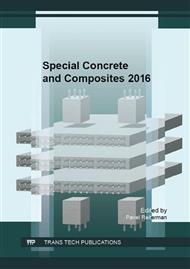[1]
J. Kočí, J. Maděra, P. Rovnaníková, R. Černý, Hygrothermal performance of innovative renovation renders used for different types of historical masonry, WIT Transactions on The Built Environment. 118 (2011) 683-93.
DOI: 10.2495/str110571
Google Scholar
[2]
V. Kočí, J. Maděra, R. Černý, Exterior thermal insulation systems for AAC building envelopes: Computational analysis aimed at increasing service life, Energy & Buildings. 47 (2012) 84-90.
DOI: 10.1016/j.enbuild.2011.11.030
Google Scholar
[3]
M. Pavlíková, Z. Pavlík, M. Keppert, R. Černý, Salt transport and storage parameters of renovation plasters and their possible effects on restored buildings' walls, Construction and Building Materials. 25 (2011) 1205-1212.
DOI: 10.1016/j.conbuildmat.2010.09.034
Google Scholar
[4]
S. Park, S. Kwon, S.H. Jung, Analysis technique for chloride penetration in cracked concrete using equivalent diffusion and permeation, Construction and Building Materials. 29 (2012) 183-192.
DOI: 10.1016/j.conbuildmat.2011.09.019
Google Scholar
[5]
ČSN EN 1015-3: Methods of test for mortar for masonry - Part 3: Determination of consistence of fresh mortar (by flow table), Prague (2007).
DOI: 10.3403/01541440
Google Scholar
[6]
E. Vejmelková, M. Pavlíková, Z. Keršner, P. Rovnaníková, M. Ondráček, M. Sedlmajer, R. Černý, High performance concrete containing lower slag amount: A complex view of mechanical and durability properties, Construction and Building Materials. 23 (2009).
DOI: 10.1016/j.conbuildmat.2008.11.018
Google Scholar
[7]
ČSN EN 1015: 11 - Determining the strength of hardened mortar bending and compressive, Prague (2000).
Google Scholar
[8]
E. Vejmelková, M. Pavlíková, M. Jerman and R. Černý, Free water intake as means of material characterization, Building Physics 33 (2009) 29–44.
DOI: 10.1177/1744259109104069
Google Scholar
[9]
ČSN 72 7031: Determination of water vapour diffusion coefficient of building materials by method without temperature gradient, Prague (2001).
Google Scholar
[10]
S. Roels, J. Carmeliet, H. Hens, O. Adan, H. Brocken, R. Černý, Interlaboratory comparison of hygric properties of porous building materials, Journal of thermal envelope and building science 27 (2004) 307–25.
DOI: 10.1177/1097196304042119
Google Scholar


